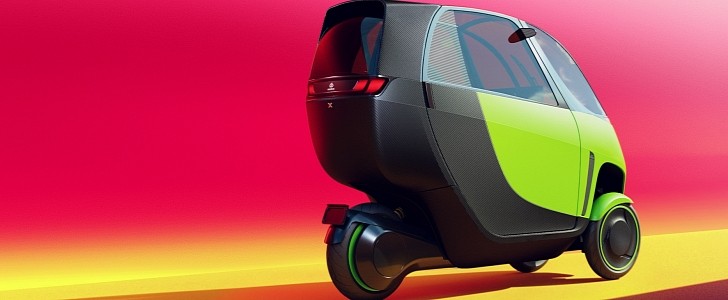When we first wrote about Nimbus and its electric trikes – the Halo and the X – the international health crisis had already killed millions of people and businesses. The semiconductor crisis was rearing its ugly head, and it also affected the startup. It planned to start offering test drives in the regions where the EV would be sold last year, but nothing happened. Nimbus told autoevolution that this was not a final interruption but only a delay.
The company also stated that it is now very close to being able to launch the two-seaters, which have a very similar proposition to that of the Aptera in terms of energy efficiency. The Halo aims to achieve 11 miles/kWh, which is equivalent to 370 MPG. The Aptera has an energy consumption of 10 mi/kWh. Everything else about them is different.
The Aptera is wide and plans to harvest energy from the sun with solar panels over its body. The Nimbus Halo just wants to be frugal in a low-weight, compact format: it is 2.3 meters (90.6 inches) long, 0.81 meters (31.9 inches) wide, and has two battery pack options. The 8.1-kWh unit offers 78 miles (126 kilometers) of range and makes the Halo weigh 639 pounds (290 kilograms). The 12.4-kWh unit makes it slightly heavier (695 lb, or 315 kg) and offers a little more range: 119 mi (191 km). Its top speed is 50 mph (80 kph).
It is a vehicle focused on urban transportation, easy to park, and very safe. Nimbus wants to build it with three airbags, ABS, traction control, lane departure warning, and a high-strength-steel and aluminum-alloy frame covered by a thermoplastic shell. Despite the safety equipment, the Halo will be affordable: $6,420. Nimbus customers will also manage to rent it for one year ($1,188, equivalent to $99 per month), six months ($774, or $129 per month), or per month ($149).
Those who want a vehicle that can be driven on highways will have to order the Nimbus X. With a top speed of 90 mph (145 kph) and a 21.7-kWh battery pack, it costs $19,400. The electric trike is only a few centimeters wider (0.84 m, or 33 in), heavier (754 lb, or 342 kg), and much faster: it goes from 0 to 60 mph (97 kph) in 3.7 seconds, with a maximum lateral acceleration of 0.93 g. Its range is 219 mi (352 km), which means it gets 10 mi/kWh.
In a few weeks, Nimbus will have a significant website refresh with up-to-date information about deliveries and preorders. Currently, it states that the first EVs will start soon in 2022 in the U.S. and Europe, Latin America will get the trike in late 2022, and Asia will receive its first units in 2023. That is certainly not the case anymore. As soon as the information is updated, we’ll let you know about that.
The Aptera is wide and plans to harvest energy from the sun with solar panels over its body. The Nimbus Halo just wants to be frugal in a low-weight, compact format: it is 2.3 meters (90.6 inches) long, 0.81 meters (31.9 inches) wide, and has two battery pack options. The 8.1-kWh unit offers 78 miles (126 kilometers) of range and makes the Halo weigh 639 pounds (290 kilograms). The 12.4-kWh unit makes it slightly heavier (695 lb, or 315 kg) and offers a little more range: 119 mi (191 km). Its top speed is 50 mph (80 kph).
It is a vehicle focused on urban transportation, easy to park, and very safe. Nimbus wants to build it with three airbags, ABS, traction control, lane departure warning, and a high-strength-steel and aluminum-alloy frame covered by a thermoplastic shell. Despite the safety equipment, the Halo will be affordable: $6,420. Nimbus customers will also manage to rent it for one year ($1,188, equivalent to $99 per month), six months ($774, or $129 per month), or per month ($149).
Those who want a vehicle that can be driven on highways will have to order the Nimbus X. With a top speed of 90 mph (145 kph) and a 21.7-kWh battery pack, it costs $19,400. The electric trike is only a few centimeters wider (0.84 m, or 33 in), heavier (754 lb, or 342 kg), and much faster: it goes from 0 to 60 mph (97 kph) in 3.7 seconds, with a maximum lateral acceleration of 0.93 g. Its range is 219 mi (352 km), which means it gets 10 mi/kWh.
In a few weeks, Nimbus will have a significant website refresh with up-to-date information about deliveries and preorders. Currently, it states that the first EVs will start soon in 2022 in the U.S. and Europe, Latin America will get the trike in late 2022, and Asia will receive its first units in 2023. That is certainly not the case anymore. As soon as the information is updated, we’ll let you know about that.










